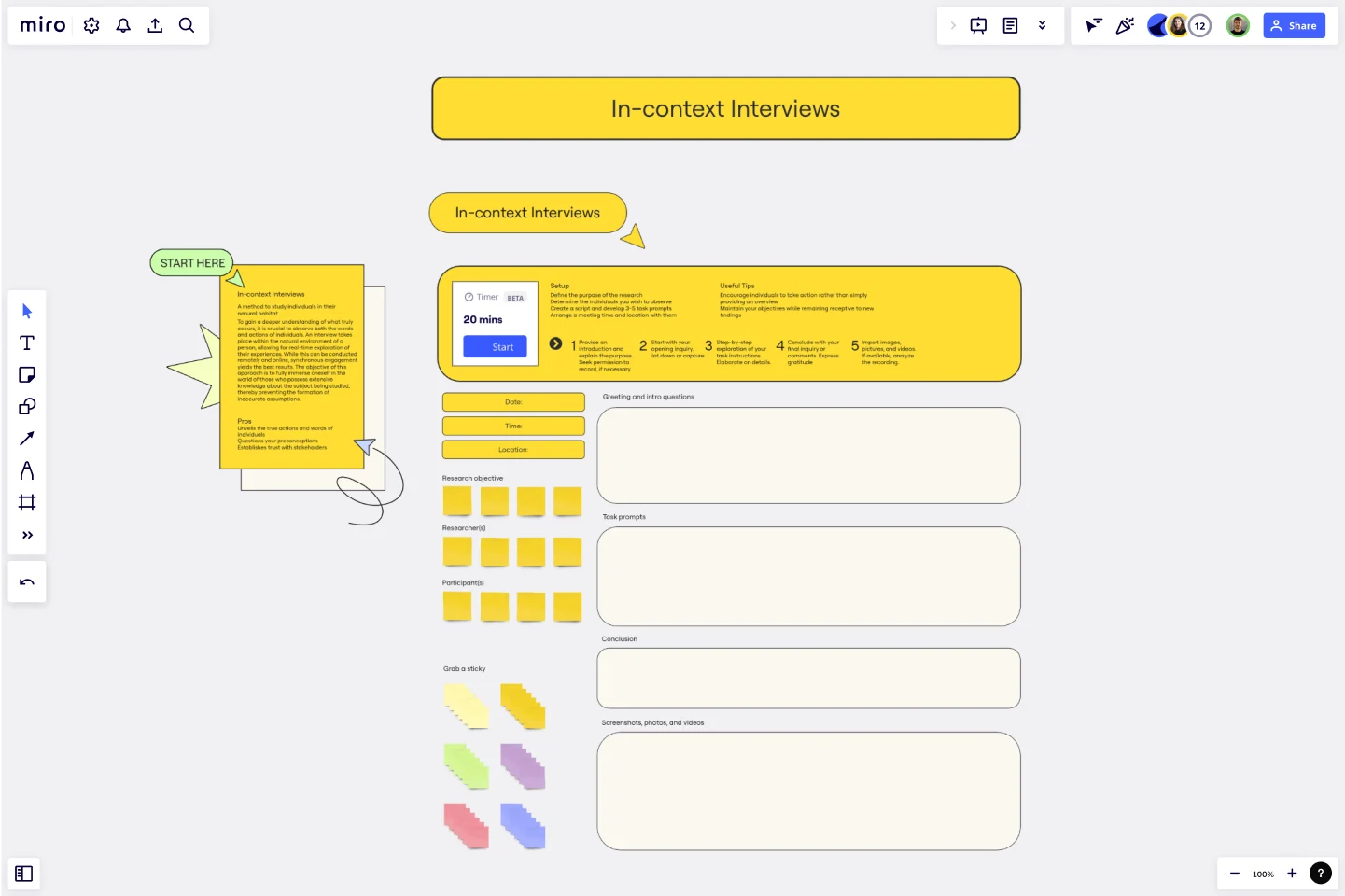In-Context Interviews Template
Gain a deeper understanding of what truly occurs with people in their natural habitat with the In-Context Interviews Template.
About the In-context Interviews Template
The In-Context Interview Template helps you study individuals in their natural habitat. To gain a deeper understanding of what truly occurs, it is crucial to observe both the words and actions of individuals.
An interview takes place within a person's natural environment, allowing for real-time exploration of their experiences. While this can be conducted remotely and online, synchronous engagement yields the best results.
The objective of this approach is to fully immerse oneself in the world of those who possess extensive knowledge about the subject being studied, thereby preventing the formation of inaccurate assumptions.
Benefits of using the In-context Interviews Template
Unveil the true actions and words of individuals.
Question your preconceptions.
Establish trust with stakeholders.
How to use the template in Miro
Provide an introduction and explain the purpose. Seek permission to record, if needed.
Start with the opening inquiry. Jot down or capture.
Step-by-step exploration of your task instructions. Elaborate on details.
Conclude with your final inquiry or comments. Express gratitude.
Import images, pictures, and videos. If available, analyze the recording.
Setup
Define the purpose of the research.
Determine the individuals you wish to observe.
Create a script.
Useful tips
Encourage individuals to take action rather than simply providing an overview.
Maintain your objectives while remaining receptive to new findings.
Get started with this template right now.
Niching Down: Online Course Persona Empathy Map
Works best for:
Market Research, Research & Design
Niching Down Online Course Persona Empathy Map helps you tailor online courses to specific personas. By understanding their needs and motivations, you can design more effective and engaging course content. Perfect for course developers and educators.
Empathy Map Canvas by Sampriti Jain
Works best for:
Market Research, Strategy & Planning
The Empathy Map Canvas template allows you to explore user behaviors and emotions comprehensively. It’s designed to help you visualize user experiences and create solutions that truly meet their needs. Perfect for UX teams and product developers.
Proto Persona Template
Works best for:
UX, UX Research, Product Design
The Proto Persona Template is tailored to capture the essence of hypothetical user segments. It encapsulates key attributes such as user needs, behaviors, and potential pain points. One of its standout benefits is its ability to foster empathy. By visualizing and understanding these preliminary user profiles, design and strategy teams can tap into a deeper connection with their target audience, ensuring that solutions resonate authentically and address genuine needs.
Empathy Map by Axelle Vanquaillie
Works best for:
Market Research, Research & Design
Empathy Mapping template is a valuable tool for gaining deep insights into user experiences. It helps you understand their motivations and challenges, ensuring your products address real needs. Ideal for UX researchers and designers.
Empathy Map Template by Jeshua MacDonald
Works best for:
Market Research, Research & Design
The Empathy Map template is essential for anyone looking to understand their audience better. It helps you gather insights into user thoughts and behaviors, allowing you to design more user-centered products and services. Perfect for UX designers and marketers.
Crazy Eights Template
Works best for:
Design Thinking, Brainstorming, Ideation
Sometimes you just need to get the team’s creative juices flowing for a brainstorm—and get them thinking of as many ideas as they can, as fast as they can. Crazy Eights will do it in a hurry. Favoring quantity over quality, this sketch brainstorming exercise challenges them to come up with eight ideas in eight minutes, which leaves no time to second guess ideas. It’s perfect for early stages of development, and it’s a team favorite for being fast paced and fun.
